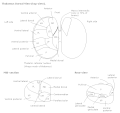You can help expand this article with text translated from the corresponding article in Italian. (November 2025)Click [show] for important translation instructions.
|
You can help expand this article with text translated from the corresponding article in Spanish. (November 2025)Click [show] for important translation instructions.
|
You can help expand this article with text translated from the corresponding article in Portuguese. (November 2025)Click [show] for important translation instructions.
|
| Medial dorsal nucleus | |
|---|---|
 Thalamic nuclei: (left thalamus from left) MNG = Midline nuclear group AN = Anterior nuclear group MD = Medial dorsal nucleus VNG = Ventral nuclear group VA = Ventral anterior nucleus VL = Ventral lateral nucleus VPL = Ventral posterolateral nucleus VPM = Ventral posteromedial nucleus LNG = Lateral nuclear group PUL = Pulvinar MTh = Metathalamus LG = Lateral geniculate nucleus MG = Medial geniculate nucleus | |
 right thalamus nuclei (above right view) | |
| Details | |
| Identifiers | |
| Latin | nucleus mediodorsalis thalami |
| MeSH | D020645 |
| NeuroNames | 312 |
| NeuroLex ID | birnlex_1543 |
| TA98 | A14.1.08.622 |
| TA2 | 5681 |
| FMA | 62156 |
| Anatomical terms of neuroanatomy | |
The medial dorsal nucleus (or mediodorsal nucleus of thalamus, dorsomedial nucleus, dorsal medial nucleus, or medial nucleus group) is a large nucleus in the thalamus. [1] [2] It is separated from the other thalamic nuclei by the internal medullary lamina.
Contents
- Structure
- Parts of nucleus
- Function
- Pain processing
- Saccadic efference copy
- Clinical significance
- Additional images
- References
- External links
The medial dorsal nucleus is interconnected with the prefrontal cortex, therefore involved in prefrontal functions. Damage to the interconnected tract or the nucleus itself will result in similar damage to the prefrontal cortex. [3] It is also believed to play a role in memory. [4]


